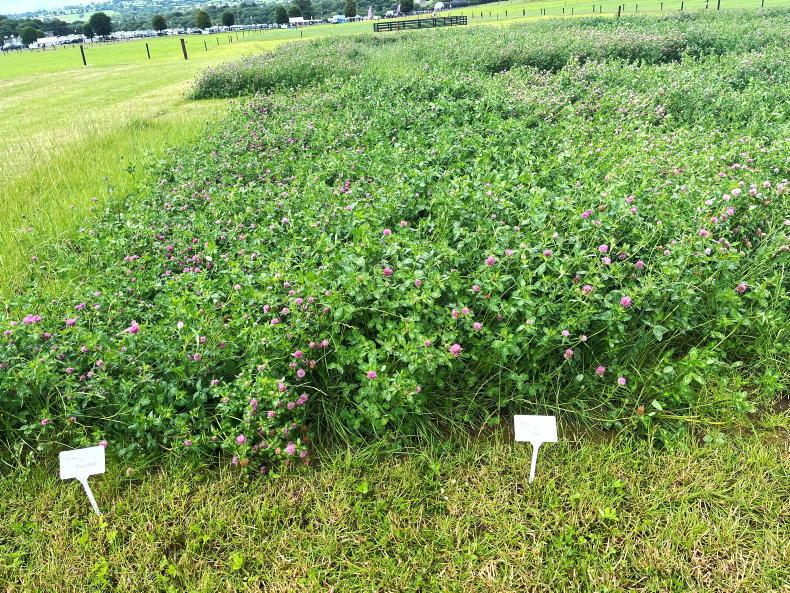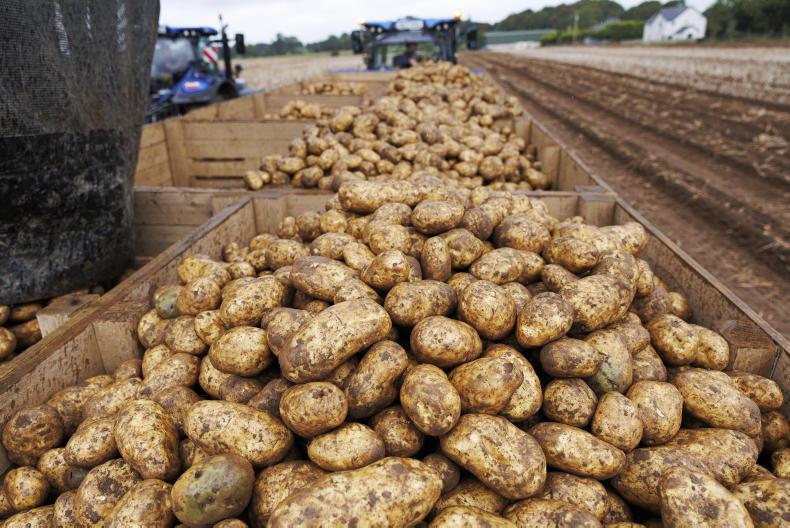The popularity of red clover silage is increasing sharply, as farmers look for ways to reduce the use of chemical nitrogen.
Red clover can fix up to 300kg N/ha of biological nitrogen from the atmosphere to the soil, which is then available for plant growth.
On top of this, red clover makes excellent quality silage with high dry matter digestibility leading to higher intakes and improved animal performance.
So, is red clover going to provide the fix for lower nitrogen rates or is that just fantasy? In my view, it is and will always be somewhat of a niche crop as opposed to a mainstream crop that we are going to see growing over a significant proportion of farms.
For one thing, its relevance is very much limited to intensive silage fields which are cut three to four times per year. Now, most farms only do one or two cuts of silage per year and graze with livestock outside of that.
Grazing with livestock isn’t an option because the growing point of red clover is higher up the stem and, if this is grazed off, the plant will die. A light grazing in the spring or autumn may be possible but this is also likely to reduce the longevity of the crop.
Having said that, many farms will have some fields that are cut for silage three or four times per year and are never grazed with stock, such as smaller parcels of an outside block.
In such cases, red clover may be a viable option on these fields as it should mean that the use of chemical nitrogen can be greatly reduced compared to grass-only swards.
However, phosphorus (P) and potash (K) are still required and at high rates.
For three cuts of red clover silage with a combined yield of 15t DM/ha, a total of 45kg P/ha and 375kg k/ha is required. This is equivalent to 12 units/acre of phosphorus and 100 units/acre of potash after each harvest. This can be supplied in about 2,500 gallons per acre of slurry, or compound fertiliser.
These fertiliser rates for P and K are no different than the recommended rates for three cuts of ordinary grass silage.
The thing to note though is that there is no flexibility around grazing when it comes to red clover, so these fields must be cut for silage and must get the high rates of fertiliser every year.
In that sense, red clover is not suited to a low-input or extensive-type system of farming – it needs to be fed with slurry or fertiliser.
It needs to be recognised that if more slurry is being directed towards the red clover fields, then there will be less available to be spread in other parts of the farm that may need it.
The flip side to that is that the red clover silage fields should be high-yielding, with 15t DM/ha the expected annual yield.
A typical first-cut crop of silage will yield 6t DM/ha, while second-cut will yield 4t DM/ha.
So two acres of red clover silage is the same as three acres of two-cut grass silage.
If on a three- or a four-cut system, the red clover will need to be cut in early May.
Most farmers will take the first cut in or around 15 to 20 May which will be mostly grass, with not much clover present.
The second cut will be taken in early July and will be about 50:50 in terms of grass to clover content, while the third cut in September will be nearly all red clover. In terms of flowering, it’s almost impossible to stop the third cut from flowering.

Red clover can fix up to 300kg N/ha of biological nitrogen from the atmosphere to the soil. \ Donal O'Leary
The fourth and final cut can be tricky because of the time of the year it will be cut at – late October and November.
Because red clover is harder to preserve anyway than ryegrass, the advice is to either take a light grazing off with cattle at the back end, or zero graze it.
Soil type would need to be good to be able to drive a zero grazer on it at that time of year.
The best time to sow red clover is in the spring. Red clover seed is far bigger than white clover seed so typical seeding rates are 4kg of red clover per acre.
Different seed mixtures are available, depending on the strategy. If looking for a short-term ley for, say, three years you could sow 4kg/acre red clover along with 1kg/acre of white clover and 9kg/acre of a hybrid ryegrass.
If looking for a more permanent sward you could sow 8kg/acre of perennial ryegrass seed, 4kg/acre of red clover seed and 1kg/acre of white clover seed.
After about four to five years, the percentage of red clover in the sward will die out but white clover should remain. White clover can be topped up by oversowing if needs be.
The three or four years at the end of the 10-year reseeding cycle without red clover will help to prevent a buildup of disease which has been a problem with red clover in the past.
After 10 years, the field can then be reseeded again with red clover.
The popularity of red clover silage is increasing sharply, as farmers look for ways to reduce the use of chemical nitrogen.
Red clover can fix up to 300kg N/ha of biological nitrogen from the atmosphere to the soil, which is then available for plant growth.
On top of this, red clover makes excellent quality silage with high dry matter digestibility leading to higher intakes and improved animal performance.
So, is red clover going to provide the fix for lower nitrogen rates or is that just fantasy? In my view, it is and will always be somewhat of a niche crop as opposed to a mainstream crop that we are going to see growing over a significant proportion of farms.
For one thing, its relevance is very much limited to intensive silage fields which are cut three to four times per year. Now, most farms only do one or two cuts of silage per year and graze with livestock outside of that.
Grazing with livestock isn’t an option because the growing point of red clover is higher up the stem and, if this is grazed off, the plant will die. A light grazing in the spring or autumn may be possible but this is also likely to reduce the longevity of the crop.
Having said that, many farms will have some fields that are cut for silage three or four times per year and are never grazed with stock, such as smaller parcels of an outside block.
In such cases, red clover may be a viable option on these fields as it should mean that the use of chemical nitrogen can be greatly reduced compared to grass-only swards.
However, phosphorus (P) and potash (K) are still required and at high rates.
For three cuts of red clover silage with a combined yield of 15t DM/ha, a total of 45kg P/ha and 375kg k/ha is required. This is equivalent to 12 units/acre of phosphorus and 100 units/acre of potash after each harvest. This can be supplied in about 2,500 gallons per acre of slurry, or compound fertiliser.
These fertiliser rates for P and K are no different than the recommended rates for three cuts of ordinary grass silage.
The thing to note though is that there is no flexibility around grazing when it comes to red clover, so these fields must be cut for silage and must get the high rates of fertiliser every year.
In that sense, red clover is not suited to a low-input or extensive-type system of farming – it needs to be fed with slurry or fertiliser.
It needs to be recognised that if more slurry is being directed towards the red clover fields, then there will be less available to be spread in other parts of the farm that may need it.
The flip side to that is that the red clover silage fields should be high-yielding, with 15t DM/ha the expected annual yield.
A typical first-cut crop of silage will yield 6t DM/ha, while second-cut will yield 4t DM/ha.
So two acres of red clover silage is the same as three acres of two-cut grass silage.
If on a three- or a four-cut system, the red clover will need to be cut in early May.
Most farmers will take the first cut in or around 15 to 20 May which will be mostly grass, with not much clover present.
The second cut will be taken in early July and will be about 50:50 in terms of grass to clover content, while the third cut in September will be nearly all red clover. In terms of flowering, it’s almost impossible to stop the third cut from flowering.

Red clover can fix up to 300kg N/ha of biological nitrogen from the atmosphere to the soil. \ Donal O'Leary
The fourth and final cut can be tricky because of the time of the year it will be cut at – late October and November.
Because red clover is harder to preserve anyway than ryegrass, the advice is to either take a light grazing off with cattle at the back end, or zero graze it.
Soil type would need to be good to be able to drive a zero grazer on it at that time of year.
The best time to sow red clover is in the spring. Red clover seed is far bigger than white clover seed so typical seeding rates are 4kg of red clover per acre.
Different seed mixtures are available, depending on the strategy. If looking for a short-term ley for, say, three years you could sow 4kg/acre red clover along with 1kg/acre of white clover and 9kg/acre of a hybrid ryegrass.
If looking for a more permanent sward you could sow 8kg/acre of perennial ryegrass seed, 4kg/acre of red clover seed and 1kg/acre of white clover seed.
After about four to five years, the percentage of red clover in the sward will die out but white clover should remain. White clover can be topped up by oversowing if needs be.
The three or four years at the end of the 10-year reseeding cycle without red clover will help to prevent a buildup of disease which has been a problem with red clover in the past.
After 10 years, the field can then be reseeded again with red clover.










SHARING OPTIONS